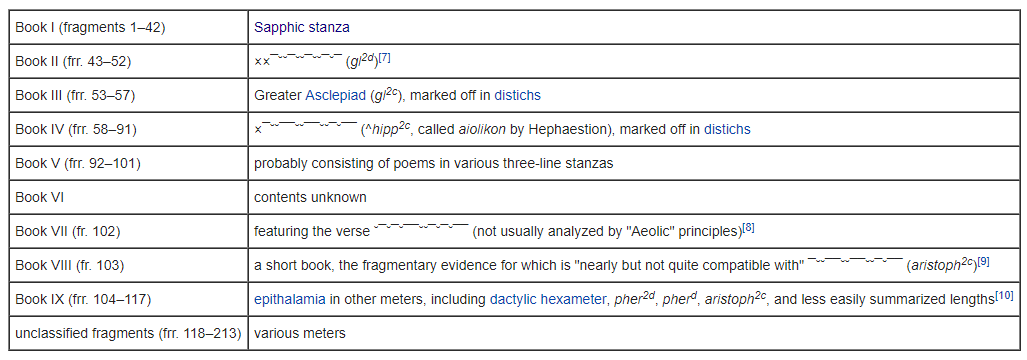The Greek Text and Commentary
The Alexandrian library had nine books (scrolls) of songs attributed to Sappho. They were arranged by meter:

My goal in editing the text was to aid the student translator as much as possible. I’ve accepted reconstructions from multiple editors to fill out the text as much as possible. I’ve moved final iotas to iota subscripts in service of more easily identifying the grammatical form; I’ve added quotation marks to indicate direct speech; and I’ve changed lunate sigmas (Ϲ) to σ and ς, except in fragments where it’s impossible to tell which.
Each poem is accompanied by a vocabulary list, with links to the LSJ (Liddell and Scott, A Greek-English Lexicon) on Perseus. As a general rule I’ve followed the lexical convention for indicating feming nouns (ἡ) and adjectives (-η), even though Aeolic uses (ἀ) and (-α). Wherever this might be confusing, however, I give the Aeolic form or both. Otherwise I maintain the Aeolic word form and indicate the Attic through the note or the link to LSJ.
Sappho’s Dialect
The Aeolic dialect was spoken on Lesbos, the coast of Asia Minor, Thessaly, and Boeotia. Sappho and the poet Alcaeus, her direct contemporary, are its primary literary representatives. Some of these forms may be familiar from reading Homeric epic, which borrowed many Aeolisms.
Features of Aeloic Dialect
|
Differences between… |
Aeolic |
Attic & Ionic |
|
No rough breathings (psilosis). NB: This affects the aspirated letters (θ, φ). |
ἴππος κατεύδω |
ἵππος καθεύδω |
|
Recession of the accent, as far back as it can go (barytonesis) |
θέος, θέων |
θεός, θεῶν |
|
Vowel changes
Primarily, long α instead of η
Οther vowel shifts |
α (λάθα) ε (κρέτος) η (γένηον) ο (στρότος) υ (ὐπίσσω) ω αι (παῖσι) οι (ὔμοι) -τα (ὄτα)
|
η (λήθη α (κράτος) ει (γένειον) α (στρατός) or ου ο (ὀπισω) ου α (πᾶσι) or η ου (ὁμοῦ) -τε (ὅτε)
|
|
Consonant changes |
π (πήλοι) σδ (φροντίσδην) σπ (σπόλα) βρ (βράκος) |
τ (τηλοῦ) ζ (φροντίζην) στ (στολή) ρ (ῥάκος) |
|
Double letters |
μμ (ὔμμες) νν (σελάννα) ρρ (χέρρες)
|
μ (ὑμεῖς) ν (σελήνη) ειρ (χεῖρες) |
|
Article (fem. sg.) |
ἀ τάν |
ἡ τήν |
|
Pronouns his/her (gen.) to him/her (dat.) him/her (acc.) |
ϝεθεν ϝοι ϝε |
|
|
We (nom.) of us (gen.) to us (dat.) us (acc.) |
ἄμμες ἀμμέων ἄμμι(ν) ἄμμε |
ἡμεῖς ἡμέων ἡμῖν ἡμέας |
|
You all (nom.) to you all (dat.) you all (acc.) |
ὔμμες ὔμμι(ν) ὔμμε |
ὑμεῖς ὑμῖν ὑμέας |
|
Nouns and Adjectives |
|
|
|
Gen. Sg. |
-ας -ω |
-ης -ου |
|
Gen. Pl. Fem. |
-αν |
-ων |
|
Dat. Pl. Masc. |
-οισι |
-οις |
|
Dat. Pl. Fem. |
-αισι |
-αις |
|
Acc. Pl. Masc. |
-οις |
-ους |
|
Acc. Pl. Fem. |
-αις |
-ας |
|
Verbs |
|
|
|
3rd pl. pres. act. indic. |
-οισι(ν) |
- ουσι(ν) |
|
Infinitives
|
-ην
ἔμμεναι |
-ειν -ναι -κεναι
εἶναι |
|
Contract verbs |
τίμαιμι φίλημι δήλωμι
τιμαισα (pres. partic) |
τιμάω φιλέω δηλόω
τιμῶσα |
|
Participles (fem. pres. act.) |
-οισα (λάβοισα) |
- ουσα (λαβοῦσα) |
|
|
|
|
|
Prepositions |
ἀπύ |
ἀπό |
|
|
ζά |
διά |
|
|
κάτ |
κατά |
|
|
ὄν(ν) |
ἀνά |
|
|
παρ |
παρά |
|
|
πεδά |
μετά |
|
|
ὐπά |
ὑπό |
|
|
|
|
|
Particles |
κε(ν) |
ἄν |
For more information, see:
Annis, William A. 2002-2007. “Lesbian Aeolic.” Aoidoi.org.
Page, Denys Lionel. 1955. Sappho and Alcaeus: An Introduction to the Study of Ancient Lesbian Poetry, 327-29. Oxford: Clarendon Press.
Smyth, Herbert Weir. 1920. Greek Grammar. Cambridge: Harvard University Press.
